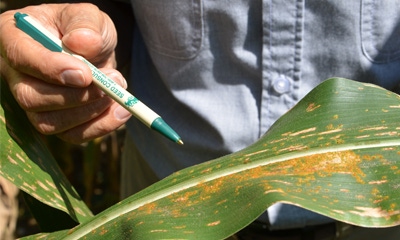September 28, 2016

I haven’t seen as much disease pressure in cornfields as I saw this year for a long time. Along with anthracnose leaf blight, we were hit by gray leaf spot, northern corn leaf blight and southern rust. Anthracnose, diplodia and gibberella ear rots and stalk rots added insult to injury. Weather was favorable to the disease organisms affecting both yield and test weight. This may be true even if the disease came in relatively late in the season.
Disease lesions reduce the photosynthetic area of leaves. When diseases attack ears, kernels can become chaffy and lose test weight.
Here are six points that discuss facts about test weight and why test weight is important.

TEST WEIGHT MATTERS: One of the most common things growers talk about each fall after yield is test weight. It’s possible late-season disease could impact test weight this year.
1. Growers often discuss the test weight of grain they harvest, especially if it is high. Grain moisture is important because of drying costs, but why is test weight important? Along with bragging rights, farmers can haul more bushels of high test-weight grain in the truck per trip to the elevator than low test-weight grain.
2. There is a penalty for low test weight, but no premium for very high test weight. Grain with lower than 56 pounds of test weight may be discounted by elevators, but no credit is given for higher test weight, even though grain with higher test weight generally has higher quality.
3. Test weight is the ratio between volume and weight, measured as the weight of grain that fills a quart container. There are 32 quarts in a bushel basket. Corn is marketed in the U.S. on the basis of 56-pound test weight per bushel. Corn with 56-pound test weight is considered No. 1 yellow corn, and 54-pound-per-bushel corn is considered No. 2 yellow corn at 15% moisture.
4. There is no direct correlation between yield and test weight. Hybrid genetics play an important role in test-weight determination and are usually mentioned in seed company literature. However, there is no correlation between test weight and yield potential of a hybrid.
5. There is a relationship between moisture and test weight. As corn grain moisture goes down, test weight increases since dry matter of grain weighs more than water.
6. High test-weight grain with deep-orange color has greater appeal. The integrity of the grain is maintained during shipping and is generally preferred by customers in foreign countries as compared to lower test-weight, chaffy grain.
Nanda is president of Agronomic Crops Consultants LLC. Email him at [email protected], or call him at 317-910-9876.
You May Also Like




